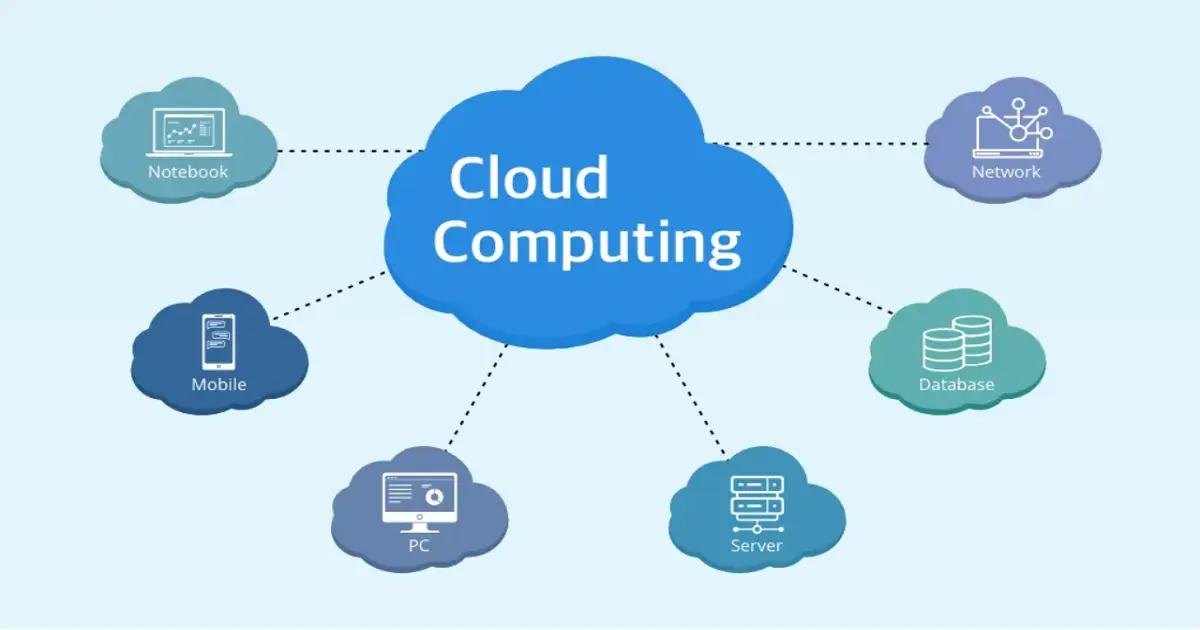Cloud computing is the on-demand availability of computing resources, such as storage, infrastructure, and applications, over the Internet. It eliminates the need for individuals and businesses to self-manage physical resources themselves, and only pay for what they use. Software of cloud computing offers many benefits, such as lower IT costs, improved agility and time-to-value, and easier scalability.
Types of Cloud Computing Services

There are three main types of cloud computing services: infrastructure as a service (IaaS), platform as a service (PaaS), and software as a service (SaaS).
Infrastructure as a Service (IaaS)
Cloud services are when you use the internet to do things like store files, run programs, or watch videos. IaaS is a type of cloud service that lets you use and control things like servers, networks, and databases. You can change them as you need and pay only for what you use. IaaS gives you more control and flexibility, but it also needs more skills and work from you. Some examples of IaaS providers are:
- Google Cloud Platform: This is a service from Google that offers many cloud products and tools.
- Amazon Web Services: This is a service from Amazon that offers many cloud products and tools.
- Microsoft Azure: This is a service from Microsoft that offers many cloud products and tools.
Platform as a Service (PaaS)
PaaS offers a develop-and-deploy environment to build cloud applications, such as web apps, mobile apps, or APIs. PaaS provides users with the tools and frameworks they need to create and run their applications, without having to worry about the underlying infrastructure or software updates. Examples of PaaS providers are Google App Engine, Heroku, and IBM Cloud Foundry.
Software as a Service (SaaS)
SaaS delivers applications as services over the internet, without requiring users to install or maintain them on their devices. SaaS provides users with ready-to-use, accessible software that can be accessed from any device with an internet connection. Examples of SaaS providers are Google Gmail, Salesforce, and Dropbox.
Types of Cloud Computing Deployment Models

There are three different cloud computing deployment models: public cloud, private cloud, and hybrid cloud.
Public Cloud
The most popular cloud deployment model is the public cloud, in which cloud services are delivered over the Internet by a third-party provider. The public cloud offers high scalability, reliability, and cost-effectiveness, but also less control and security over the data and resources. Anyone can access public cloud services with an internet connection and a valid account.
Private Cloud
Private clouds are cloud services that are provided by an organization for its own use. Although private clouds offer greater control and security over data and resources, they are also less scalable, reliable, and cost-effective. It is possible to host private cloud services on-site or off-site with a third-party provider.
Hybrid Cloud
Cloud services are when you use the internet to do things like store files, run programs, or watch videos. Sometimes, you may want to use different types of cloud services for different purposes. For example, you may want to use:
- Public cloud: This is when you use cloud services that are shared with other users and offered by a cloud provider. The public cloud is cheaper and easier to use, but it may not be very secure or reliable.
- Private cloud: This is when you use cloud services that are only for you and run by yourself or a trusted partner. Private cloud computing is more secure and reliable, but it is also more expensive and harder to use.
A hybrid cloud is when you use both public and private cloud services together. You can choose the best cloud service for your needs and goals. A hybrid cloud can give you more flexibility and options, but it can also be more complicated and difficult to manage. You need to connect your different cloud services in a way that works well for you. You can do this by using:
- APIs: These are ways for different cloud services to talk and work with each other.
- VPNs: These are ways for different cloud services to connect and share data securely.
Challenges of Cloud Computing
Despite the many benefits and opportunities of cloud computing, there are also some challenges and risks that need to be addressed and mitigated. Some of the common challenges of cloud computing are:
Security and Privacy
Cloud services are when you use the internet to do things like store files, run programs, or watch videos. Sometimes, you may have data that is private or important, and you don’t want anyone else to see or change it. You need to make sure that your data is safe and secure when you use cloud services.
Cloud providers are the people who offer cloud services. They need to follow some rules and standards to keep your data safe and secure. Some of these rules and standards are:
- GDPR: This is a rule that protects your personal data in the European Union.
- HIPAA: This is a rule that protects your health data in the United States.
- PCI DSS: This is a rule that protects your payment data when you buy things online.
- ISO 27001: This is a standard that helps cloud providers manage their security systems.
Cost Management
Cloud services are when you use the internet to do things like store files, run programs, or watch videos. Cloud services can help you save money compared to buying and running your own IT equipment and software. But cloud services can also cost you more than you expect if you don’t manage them well. You need to keep track of how much you use and spend on cloud services, and understand how they charge you for different things. You also need to think about the total cost of cloud services, which includes not only the money you pay for them, but also the money you spend on moving, connecting, learning, helping, and fixing them.
Performance and Reliability
Cloud services are when you use the internet to do things like store files, run programs, or watch videos. Cloud services can be fast and reliable, but they can also have problems sometimes. For example, they can be slow, stop working, or not work well because of things like:
- Too many people are using the internet at the same time.
- Something is breaking or going wrong with the equipment or software.
- Someone is making a mistake or trying to hack the cloud services.
Integration and Interoperability
Cloud services are when you use the internet to do things like store files, run programs, or watch videos. Sometimes, you may want to use cloud services with your old systems and data, or with other cloud services from different places. But this can be hard to do because they may not work well together. You need to make sure that your cloud services can work with your old systems and data, and with other cloud services. You also need to use the same rules and ways to share and talk with different cloud services.
Skills Gap
Cloud services are when you use the internet to do things like store files, run programs, or watch videos. Cloud services can help you do new and better things, but they can also be hard to use. You need to know a lot about cloud services to choose the best ones for you and use them well. You also need to learn new things all the time because cloud services change fast and you want to stay ahead of others. But there are not enough people who know a lot about cloud services, which can make it hard for you and others to use cloud services well.
Future Trends of Cloud Computing

Cloud computing is not a static technology, but a constantly evolving and innovative field that responds to the changing needs and demands of customers, businesses, and society. Here are some of the future trends that are shaping the direction and growth of cloud computing.
Cloud Ubiquity
Cloud services are when you use the internet to do things like store files, run programs, or watch videos. You can use cloud services on different devices, such as phones, computers, or smart gadgets. You can also use cloud services from different places, such as your home, office, or car.
Cloud ubiquity is when cloud services work well on any device and in any place. You can use cloud services whenever you want, wherever you are, and however you like. You don’t have to worry about the speed, safety, or quality of the internet connection. In addition, you can also choose the best cloud services for your needs and goals. Additionally, you can mix and match different cloud services from different providers and platforms.
Regional Cloud Ecosystems
Cloud services are when you use the internet to do things like store files, run programs, or watch videos. Sometimes, these services are based in different parts of the world, such as Asia, Europe, or America. This can affect how well they work for you and your needs.
Some people want to have cloud services that are closer to where they live or work. They call these regional cloud ecosystems. Additionally, they have different reasons for this, such as:
- They want to follow the rules and laws of their country or region.
- Moreover, they want to protect their data and privacy from other countries or regions.
- In addition, they want a faster and better internet connection and performance.
- They want to have more choices and options that suit their local needs and wants.
- Moreover, they want to support their local economy and environment.
Sustainability and Carbon-Intelligent Cloud
Cloud computing is when you use the internet to store and process data. Sometimes, cloud computing can harm the environment and make climate change worse. This is because it uses a lot of energy and creates carbon dioxide. Carbon dioxide is a gas that traps heat in the air.
Some people want to make cloud computing better for the environment. They call this sustainability and a carbon-intelligent cloud. Using less energy or using energy from the sun, wind, or water. Sharing resources with other users so they don’t waste space or power. Balancing the load of work so they don’t use more energy than they need. Measuring how much carbon dioxide they make and finding ways to reduce it or cancel it out. Sustainability and a carbon-intelligent cloud can help customers who care about the environment. They can also help the world fight against climate change.
Automated Programmable Infrastructure
Automated programmable infrastructure refers to the use of artificial intelligence (AI) and machine learning (ML) to automate and optimize the management and operation of cloud infrastructure and platform services. Moreover, automated programmable infrastructure involves various capabilities, such as self-healing, self-scaling, self-optimizing, self-securing, and self-governing. Additionally, automated programmable infrastructure enables customers to achieve higher levels of efficiency, agility, reliability, security, and cost-effectiveness.
If you want to know where WhatsApp backup is stored let’s delve into this article.
Conclusion
Cloud computing is a powerful and versatile technology that enables customers to use infrastructure and applications via the Internet, without installing and maintaining them on-premises. Cloud computing offers different types of services and deployment models to suit different needs and preferences. In addition, cloud computing is transforming the way we work, learn, communicate, and collaborate in the digital era.
FAQs
Q1: What are the benefits of cloud computing?
Cloud computing offers many benefits, such as lower IT costs, improved agility and time-to-value, and easier scalability.
Q2: What are the challenges of cloud computing?
Some of the common challenges of cloud computing are security and privacy, cost management, performance and reliability, integration and interoperability, and the skills gap.
Q3: What are the future trends in cloud computing?
Some of the future trends that are shaping the direction and growth of cloud computing are cloud ubiquity, regional cloud ecosystems, sustainability, carbon-intelligent cloud, and automated programmable infrastructure.
Q4: What are some examples of cloud computing providers and platforms?
Some of the popular and well-known cloud computing providers and platforms are Google Cloud Platform, Amazon Web Services, Microsoft Azure, Google App Engine, Heroku, IBM Cloud Foundry, Google Gmail, Salesforce, and Dropbox.
Q5: What are some of the use cases and applications of cloud computing?
Cloud computing can be used for various purposes and domains, such as web hosting, data storage and backup, data analytics, and processing





